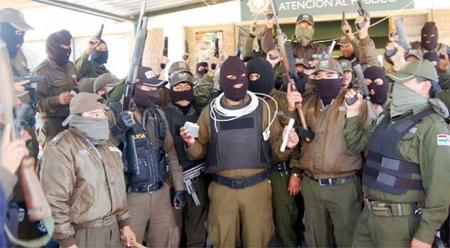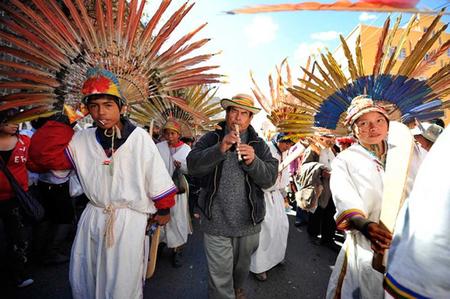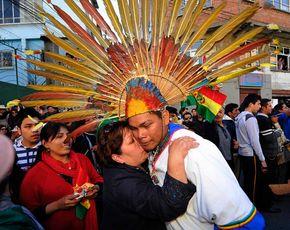Some 1,500 indigenous marchers and their allies arrived in La Paz on June 27, after a 62-day, 360 mile trek from the Amazonian lowlands to protest the Bolivian government’s proposed highway through the Isiboro-Sécure Indigenous Territory and National Park (TIPNIS).
This second national TIPNIS march arrived at a moment of high tension, even for conflict-prone Bolivia. Just hours earlier, President Evo Morales had settled a violent national police mutiny that roiled the capital city for six days. Morales also attracted international attention with allegations that a right-wing coup, implicating both the police and the TIPNIS protesters, was in the making.
Between June 20 and June 26, armed rank-and-file officers (and their wives) engaged in a series of violent provocations, including attacks on the national police headquarters and other elite police facilities, to underscore their demand for wage parity with the armed forces. As the protest shut down police operations in La Paz and spread to other departmental capitals, Morales deployed troops into the streets of Bolivia’s major cities.

Morales claimed that conservative opposition forces had infiltrated the police protest in an effort to set the stage for a political coup. Further, according to Vice President Alvaro García Linera, the government had evidence of a “Plan TIPNIS,” a right-wing strategy to link the police mutiny with the approaching TIPNIS march in order to destabilize and overthrow the Morales government. As one MAS (Movement Towards Socialism) governor cautioned, “both the police mutiny and the indigenous march are seeking violence or confrontation, as well as deaths, in order to blame the government.”
Fernando Vargas, president of the TIPNIS Subcentral, was quick to refute the charge. “Our mobilizations were never [intended] to overthrow the government but, on the contrary, have been to redirect government policies that have gone astray,” he stated.
Police rebels, too, insisted that their mobilization was strictly a labor action. According to the Andean Information Network (AIN), the police have had legitimate grievances against Morales, whom they perceive as exacerbating traditional rivalries between the police and the military. Prior to the strike settlement, rank-and-file police officers earned 30% less than their armed forces counterparts. Resentment has mounted due to shrinking police budgets, removal of ID card and drivers’ license administration (a substantial source of unregulated income) from police control, and Morales’ recent installation of an unpopular new National Police Commander.
The police also feel scapegoated for their role in managing social conflicts, such as the first TIPNIS march, where Morales blames rogue (or politically-motivated) police for the violent repression of indigenous marchers at Chaparina. The police insist that they were only acting under government orders.
It’s not the first time that Morales has accused protest movements—including the TIPNIS marchers—of links to outside forces (such as the U.S. Embassy and right-wing opposition groups) who are seeking to destabilize his government. Protest leaders view these allegations largely as a tactic to undermine their credibility and mobilize support for the government.

Coming on the heels of the recent coup against leftist president Fernando Lugo in Paraguay, the charges in this case may have seemed plausible to many. Also, Bolivians have not forgotten the events of Febrero Negro (Black February) in 2003, where a police revolt—over a tax increase—left at least 18 dead and 80 wounded after a shootout with the army in the Plaza Murillo, setting the stage for the popular revolt that ousted neoliberal president Gonzalo Sánchez de Lozada 8 months later. To date, though, the government has offered little in the way of concrete evidence to back up its case for a coup in the making.
As Kathryn Ledebur of AIN recently told Al Jazeera, “There are legitimate demands and political issues; it's always a combination of complex factors in Bolivian protests.” Still, she argues, it strains credibility to imagine that the police, who are widely regarded as corrupt and inefficient, could muster enough popular support to engineer a coup.
At the end of the day, the police strike was resolved fairly quickly through a negotiated settlement with the government, including a $15 per month (22%) pay increase, improved retirement benefits, scuttling of the problematic new disciplinary code, and a promise of protection against reprisals for rebel leaders. As ex-MAS governor Rafael Puente notes, no coup in history has been warded off so easily. A more credible view is that the police protesters took advantage of the imminent arrival of the TIPNIS marchers to position the government and negotiate the best possible settlement they could get.
For their part, the TIPNIS marchers purposefully delayed their arrival into La Paz until after the police strike was settled, to avoid any appearance of collusion between the two protests. Back on duty, the same police who just a few hours earlier were exercising their own right to protest lost no time in pepper-spraying the marchers to keep them away from the Plaza Murillo. The marchers responded by taunting them with a chant: “Vendidos por $100 bolivianos!” (sold out for $15 a month).
Inside the city, the march was forced to detour to avoid a pro-government counter-march convoked by MAS government officials to defend the government against the alleged coup threat. Some 2,000 campesinos, miners, and highland indigenous leaders from the 20 provinces of La Paz, and from trade union and neighborhood sectors in El Alto—the traditional bastions of MAS support—participated in this mobilization. Meanwhile, thousands of Paceños expressed their solidarity with the TIPNIS marchers by forming a human chain along their route to shield them from potential reprisals.

The TIPNIS marchers have vowed to remain in the capital until the Morales government meets their demands—principally, cancellation of the consulta that the government is carrying out with TIPNIS communities to decide the fate of the proposed road, which the protesters regard as illegitimate. To date, the government has refused to meet with march leaders because of their alleged involvement in a variety of criminal activities (such as wood trafficking, gambling, and minor drug smuggling). The protesters have observed the irony of this position, coming from a government whose vice-president served 5 years in prison for insurrection and terrorism, and a cocalero president labeled as a narcotrafficker by Sánchez de Lozada, who refused to negotiate with him.
Despite this apparent stalemate, the second TIPNIS march has already achieved a great deal. In addition to Morales’ cancellation of the TIPNIS road contract last April, which also terminated its financing, Bolivia’s Plurinational Constitutional Tribunal recently ruled that the consulta can only be carried out legitimately if consensus is first achieved among the affected indigenous communities. While the government argues that 65% of the TIPNIS communities support the consulta, many observers believe that the current process will have to be suspended to comply with the court’s ruling as it affects the other 35%. At a minimum, the timeframe for the consulta will likely be extended, perhaps indefinitely.
Indirectly, the TIPNIS march has also provided a two-month "window of opportunity" for a variety of other sectors—including doctors, health workers, miners, and now police officers—to press their claims with the Morales government, at a moment when the government might be incentivized to offer concessions. It’s a far cry from a coup conspiracy, but a good example of pragmatic protest politics at work in Bolivia.
Emily Achtenberg is an urban planner and the author of NACLA’s weekly blog Rebel Currents, covering Latin American social movements and progressive governments (nacla.org/blog/rebel-currents). She visited El Salvador in June with the Cambridge–El Salvador Sister Cities delegation.

